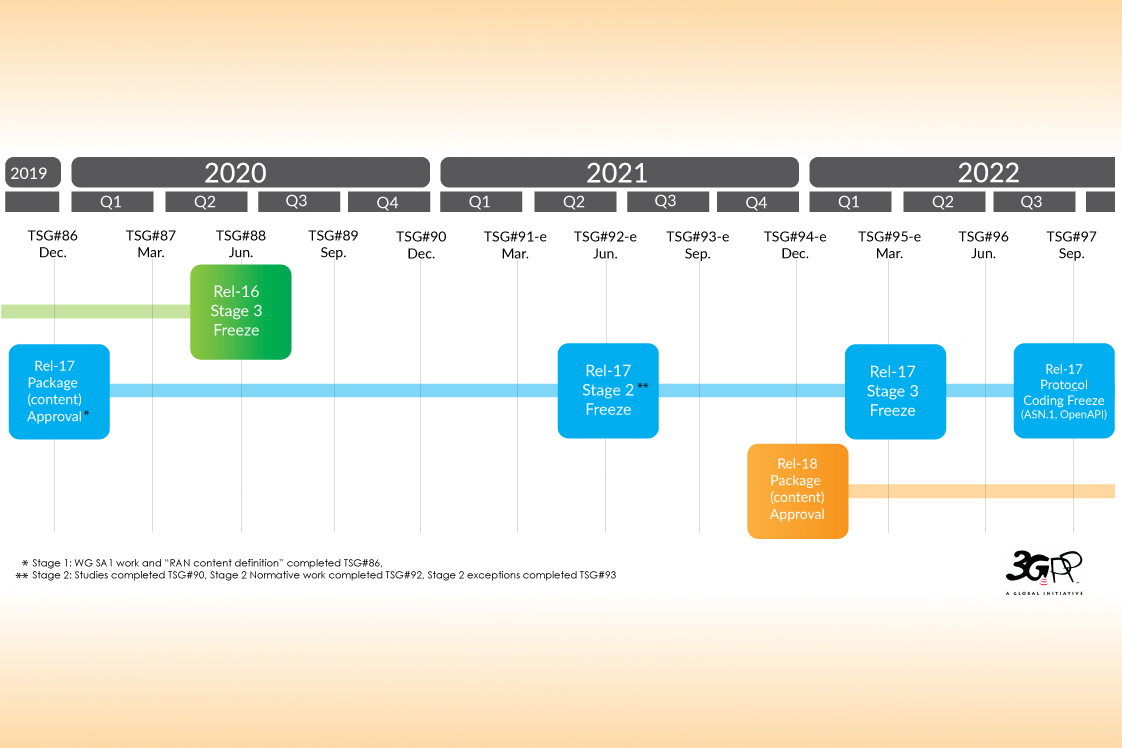The current schedule envisages that the most important work on Release 17 will be completed soon; work on Release 18 has already begun. (Source: 3GPP)
The 5G mobile radio standard is soon to be improved and expanded again: the technical standards of Release 17 will be finalized in March, the implementation protocols by September 2022. At the same time, shortly before the end of the year, the standardization committee adapted to the work plan for Release 18. The additions associated with 5G R18 justify a new name, according to 3GPP: 5G Advanced.
The corona pandemic is also making itself felt in the further development of the 5G mobile communications standard. Since meetings of the working groups can only take place virtually, it has become more difficult to find agreement on contentious issues. More meetings had to be scheduled and schedules had to be stretched several times.
The latest schedule for Release 17 (R17), which is currently in the works, provides for the finalization of the technical specifications by the end of the first quarter (“Stage 3 Freeze”). All further work should be completed by September 2022 at the latest (“Protocol Coding Freeze”). Until recently, the target was even June 2022. However, another important topic came up at short notice, which the standardization committee gives high priority to. 3GPP was able to agree with the Indian counterpart Telecommunications Standards Development Society India (TSDSI) to integrate the Indian 5G extension “5Gi” into 3GPP R17. The key feature of 5Gi is Low Mobility Large Cell (LMLC), a technology that greatly extends a base station’s signal transmission range to provide coverage in rural areas with fewer cell towers..
Not even R16 arrived on the market
Approving a standard is one thing, translating it into real products is another. After the adoption of the 5G Release 16 in July 2020 followed, for example, with the Snapdragon X65 and the Mediatek M80 does have corresponding chipsets that are fully R16 compatible. However, the availability of these and other modem chips has been poor to this day. In the current chip crisis, the manufacturers of smartphones are primarily served with suitable SoCs, the developers of industrial 5G routers are at best in the second row. But at least in the course of this year there should be a larger selection of communication modules and routers that already take the Release 16 functions into account. Market observers do not expect the specifications from Release 17 to be implemented before the first quarter of 2023, rather later.
What Release 17 will bring
The enhancements and additions to the 5G standard will benefit IoT applications in particular. These include, for example:
- RedCap (ReducedCapacity) for 5G devices with reduced capacity, which position themselves between high-quality eMBBservices and the services with low complexity based on LTE-MTC and NB-IoT, with higher transmission data thanNB-IoT, but lower cost than multi-bit devices;
- Advanced Dynamic Spectrum Sharing (Advanced DSS), which increases the number of operable end devices by using a secondary cell;
- Improving spectral efficiency and system capacity, support for URLLC in unlicensed frequency environments, and measures to support real-timenetworks;
- Improving accuracy of 5G positioning for specific use cases, such as factory automation, to 20 to 30 cm, as well as reducing latency to enable positioning in time-critical use cases and introducing new performance indicators to ensure reliability and integrity of positioning functions;
- Extended possibilities for the integration of end devices into Non Public Networks (NPN), so that campus networks can be used in a similar way to public networks;
- Discover edge capabilities on the network so that it dynamically routes to local application and data storage servers;
- Advanced sidelink communication, such as for V2X applications in vehicles;
- Higher transmission speeds, better network coverage and lower energy requirements for small data services (LTE-MTC, NB-IoT);
- Improvements in beamforming and MIMO (multiple-input, multiple-output);
- Support for multi-SIM devices;
- Broadcast and multicast services via 5G;
- Support for satellite radio (“non terrestric networks”), e.B. by LEO (Low Earth Orbit) satellites;
- Expansion of the usable spectrum to frequencies above the previously used range of mmWaves (24.25to 6 GHz, “high-band”) up to 71 GHz.
Release 18 work plan set
While the functions in Release 17 have already been fixed and are only awaiting final specification, work on the follow-up Release 18 (R18) has only just begun. After more than half a year of intensive consultations, the standardization committee has now agreed on a work plan. However, it is not yet possible to say whether all points will ultimately be implemented or whether individual measures will be postponed to the next release, as has happened several times in the past.
A major topic for 5G R18 are further improvements in energy efficiency, both in the area of antennas and in the area of network technology. For the RedCap devices defined with Release 17, further power-saving measures and possibilities for further cost reduction are to be found. For example, it is being investigated whether energy harvesting can be used.
The keyword National Security and Public Safety (NSPS) refers to functions that provide reliable, protected communication, for example for rescue services. XR aims to support various forms of augmented reality and virtual reality services. Furthermore, the use of artificial intelligence and machine learning is planned, both to optimize the physical layer and in the area of transmission and reception technology (Radio Access Network, RAN). And last but not least, the use of full-duplex data transmission at the base station, with simultaneous transmission and reception via TDD bands.
The standardization committee provides the detailed collection of topics for Release 18, which virtually represents the work plan for the various working groups within the 3GPP, on its website.
From 2025 “5G Advanced”
According to the current schedule, the development of the specifications for Release 18 should start now and be completed by the end of 2023. Implementation could then take place in late 2024 or early 2025.
The public will certainly not miss the market launch of 5G R18. The changes that have accumulated from the first 5G specification with Release 15 to Release 18 are so serious for the standardization organization that 3GPP has decided that 5G R18 networks can be called “5G Advanced”. The corresponding logo is already finished.










Leave A Comment